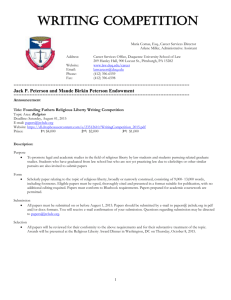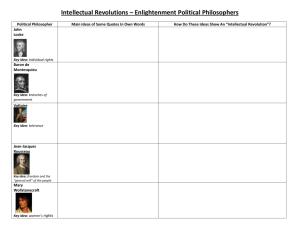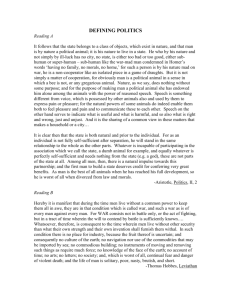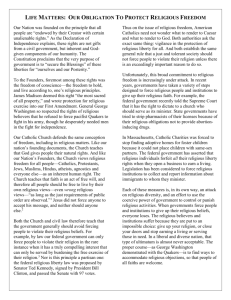Carhart Amicus Brief
advertisement
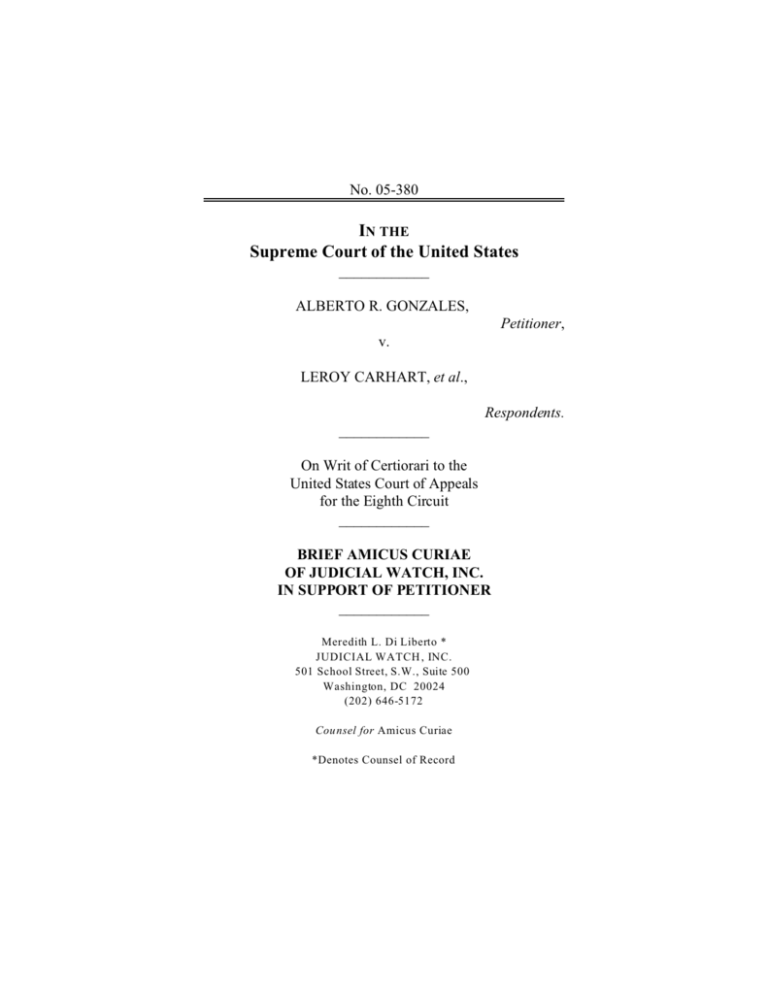
No. 05-380 IN THE Supreme Court of the United States ____________ ALBERTO R. GONZALES, Petitioner, v. LEROY CARHART, et al., Respondents. ____________ On Writ of Certiorari to the United States Court of Appeals for the Eighth Circuit ____________ BRIEF AMICUS CURIAE OF JUDICIAL WATCH, INC. IN SUPPORT OF PETITIONER ____________ Meredith L. Di Liberto * JUDICIAL WATCH , INC. 501 School Street, S.W., Suite 500 Washington, DC 20024 (202) 646-5172 Cou nsel for Amicus Curiae *Denotes Counsel of Record i TABLE OF CONTENTS Page INTEREST OF THE AMICUS CURIAE . . . . . . . . . . . . . . 1 SUMMARY OF THE ARGUMENT . . . . . . . . . . . . . . . . 2 ARGUMENT ........................................3 I II. The Partial Birth Abortion Ban Act of 2003 Is Constitutional Because Congress Drafted It Within the Confines of This Court’s “Liberty Interest” Jurisprudence . . . . . . . . . . . . . . . . 3 A. The Jurisprudence of Liberty Interests . . . . . . . . . . . . . . . . . . . . . 3 B. The Government May Restrict Liberty Interests . . . . . . . . . . . . . . . 6 C. The Partial Birth Abortion Ban Act of 2003 Is a Legitimate Restriction and Proper Balancing of Liberty Interests . . . . 9 The Holding in Stenberg v. Carhart Is Contrary to This Court’s “Liberty Interest” Jurisprudence and Should Be Overruled . . . . . . . 11 CONCLUSION . . . . . . . . . . . . . . . . . . . . . . . . . . . . . . . . 12 ii TABLE OF CITATIONS Cases Page Carhart v. Ashcroft, 331 F. Supp. 2d 508 (D. Neb. 2004) . . . . . . . . . . . . . . . . . . . . . . . . . . . . 9 Carhart v. Gonzalez, 413 F.3d 791 (3rd Cir. 2005) . . . . . . 2 Casey v. Planned Parenthood, 505 U.S. 833 (1992) . . . . . . . . . . . . . . . . . . . . . . . . . . . . . . 6-7, 11 Cruzan v. Misssouri, 497 U.S. 261 (1990) . . . . . . . 5, 8, 11 Eisenstadt v. Baird, 405 U.S. 438 (1972) . . . . . . . . . . . . . 5 Griswold v. Connecticut, 381 U.S. 479 (1965) . . . . . . 4, 12 Lawrence v. Garner, 539 U.S. 558 (2003) . . . . . . . . . . 5, 8 Linkletter v. Walker, 381 U.S. 618 (1965) . . . . . . . . . . . . 12 Meyer v. Nebraska, 262 U.S. 390 (1923) . . . . . . . . . . . . . . 4 Palko v. Connecticut, 302 U.S. 319 (1937) . . . . . . . . . . . . 5 Roe v. Wade, 410 U.S. 113 (1973) . . . . . . . . . . . . . . passim Stenberg v. Carhart, 530 U.S. 914 (2000) . . . . . . . . . . . . . . . . . . . . . . . . . . . . . . passim iii Statutes and Rules 18 U.S.C. § 1531 . . . . . . . . . . . . . . . . . . . . . . . . . . . passim Supreme Court Rule 37.3(a) . . . . . . . . . . . . . . . . . . . . . . . 1 Supreme Court Rule 37.6 . . . . . . . . . . . . . . . . . . . . . . . . . . 1 Miscellaneous Haskell, Martin, M.D., Second Trimester D&X, 20 Wks and Beyond, (September 1992 seminar) . . . . . . . . 9 1 BRIEF OF AMICUS CURIAE IN SUPPORT OF PETITIONERS Judicial Watch, Inc. (“Judicial Watch”) respectfully submits this brief amicus curiae in support of Petitioner Attorney General Alberto R. Gonzalez. Pursuant to Supreme Court Rule 37.3(a), counsel for the parties have consented to the filing of this amicus brief.1 Letters of consent to the filing of this brief have been filed with the Clerk of the Court. INTEREST OF THE AMICUS CURIAE Judicial Watch is a public interest organization headquartered in Washington, D.C. Founded in 1994, Judicial Watch seeks to promote accountability, transparency and integrity in the law, as well as ethics and morality in public life. Since its inception more than ten years ago, Judicial Watch has filed hundreds of lawsuits in state and federal courts across the nation in pursuit of these goals. Judicial Watch is participating as amicus in this case for two primary reasons. First, the laws of this nation rely on the proper functioning of the courts, including a proper balance of powers and the judiciary’s ability to demonstrate restraint. Judicial Watch believes this case is an important opportunity for the Court to clarify its liberty interest jurisprudence. Second, as a frequent public interest litigant, Judicial Watch relies on consistent application of 1 Pursuant to Rule 37.6, Judicial Watch states that no counsel for any party authored this brief in who le or in p art, and no person or entity other than the amicus curiae made a mone tary contribution to the prep aration or submission of this brief. 2 constitutional law and precedent in its legal advocacy. The opinion of the U.S. Court of Appeals for the Eighth Circuit (“Eighth Circuit”) in Carhart v. Gonzalez, 413 F.3d 791 (3rd Cir. 2005) demonstrates the effect of inconsistently applied concepts of law and precedent; in particular, this Court’s opinion in Stenberg v. Carhart, 530 U.S. 914 (2000), which represents a departure from precedent and should be overruled. SUMMARY OF THE ARGUMENT Abortion is the most contentious domestic issue today. Indeed, it has been the most contentious domestic social issue for more than thirty years. Roe v. Wade did not provide the final word on abortion, rather it served as the starting point for years of legal debate. The subject matter before this Court is partial birth abortion and whether the Partial Birth Abortion Ban Act of 2003 (“Act”) is unconstitutional. See 18 U.S.C. § 1531. The U.S. Court of Appeals for the Eighth Circuit (“Eighth Circuit”) found the Act unconstitutional based in large part on this Court’s holding in Stenberg v. Carhart. The Eighth Circuit’s opinion should be reversed and the injunction lifted. The Partial Birth Abortion Ban Act is constitutional because Congress drafted the Act within this Court’s liberty interest jurisprudence. The Act represents a legitimate restriction of the qualified right to abortion because it takes into consideration the liberty interests of both the woman and the partially born baby and properly balances them. 3 Stenberg represents a divergence of this Court’s liberty interest jurisprudence, and it should be overruled. ARGUMENT I. The Partial Birth Abortion Ban Act of 2003 Is Constitutional Because Congress Drafted It Within the Confines of This Court’s “Liberty Interest” Jurisprudence. The Partial Birth Abortion Ban Act (“Act”) was not passed in a bubble. In fact, Congress considered and passed partial birth abortion bans on several prior occasions. During each congressional session, extensive testimony and medical evidence was presented. It was also apparent from the hearing transcripts that Congress took great care to consider the law and legal implications of the ban. What Congress passed in 2003 was a narrowly tailored law reflective of this Court’s liberty interest jurisprudence. A. The Jurisprudence of Liberty Interests. “[B]ut as for me, give me liberty, or give me death!” The impassioned cry of Patrick Henry in 1775 became a call to arms, a call to join the fight against the tyranny and control of the English. It was against this bloody and hardfought background that the Founding Fathers boldly proclaimed the unalienable rights of “Life, Liberty, and the pursuit of Happiness” in the Declaration of Independence. For the next two hundred and thirty years, the meaning of those words, and “liberty” in particular, would be debated, argued over, interpreted and reinterpreted by this Court. 4 This Court has not compiled an exhaustive list of liberty interests, but it has spoken frequently on the subject and set out certain types of conduct and actions that have been deemed to be liberty interests. The Court held that: [W]hile this Court has not attempted to define with exactness the liberty thus guaranteed, the term has received much consideration and some of the included things have been definitely stated. Without doubt, it denotes not merely freedom from bodily restraint but also the right of the individual to contract, to engage in any of the common occupations of life, to acquire useful knowledge, to marry, establish a home and bring up children, to worship God according to the dictates of his own conscience, and generally to enjoy those privileges long recognized at common law as essential to the orderly pursuit of happiness by free men. Meyer v. Nebraska, 262 U.S. 390, 399 (1923). In his concurring opinion in Griswold v. Connecticut, 381 U.S. 479, 486 (1965), Justice Goldberg wrote that “the concept of liberty protects those personal rights that are fundamental, and is not confined to the specific terms of the Bill of Rights.” Building on this idea of liberty interests, the Court later equated liberty interests with a “right to personal privacy, or a guarantee of certain areas or zones of privacy.” See Roe v. Wade, 410 U.S. 113, 5 151 (1973). These personal rights were those “‘fundamental’ or ‘implicit’ in the concept of ordered liberty.” Id. (quoting Palko v. Connecticut, 302 U.S. 319, 325 (1937)). Continuing to build on this liberty interest theory, the Court held that the “rational continuum” and “full scope of liberty” included: [T]he right of the individual, married or single, to be free from unwarranted governmental intrusion into matters so fundamentally affecting a person as the decision whether to bear or beget a child. Eisenstadt v. Baird, 405 U.S. 438, 453 (1972). The following year the Court added to the list of liberty interests the limited “right of a woman to decide whether or not to terminate her pregnancy.” Roe, 410 U.S. at 170. And so, Roe gave birth to the qualified liberty interest called abortion. Since 1973, the Court has confirmed the liberty interest of abortion and extended the concept of liberty interest to include such actions as: the liberty interest of refusing medical treatment, Cruzan v. Misssouri, 497 U.S. 261, 278-79 (1990); and the liberty interest of engaging in homosexual sexual conduct, Lawrence v. Garner, 539 U.S. 558, 567 (2003). In each of these cases, the Court based its decision on the particular act or conduct being one encompassing “the most intimate and personal choices a person may make in a lifetime, choices central to personal dignity and autonomy, are central to the liberty protected by 6 the Fourteenth Amendment.” Casey v. Planned Parenthood, 505 U.S. 833, 851 (1992). The Court further held in Casey that “at the heart of liberty is the right to define one’s own concept of existence, of meaning, of the universe, and of the mystery of human life.” Id. In the Court’s most recent abortion case, the majority opinion held that the Nebraska Partial-Birth Abortion Ban would be considered “in light of the Constitution’s guarantees of fundamental individual liberty” which “offers basic protection to the woman’s right to choose.” Stenberg v. Carhart, 530 U.S. 914, 921 (2000). The Court opted not to “revisit those legal principles,” but instead to apply them to Nebraska’s Partial-Birth Abortion Ban. However, there is no further mention of liberty or liberty interests in the Court’s majority opinion, nor were those principles of liberty applied. B. The Government May Restrict Liberty Interests. Even while expanding the list of liberty interests, the Court has always been careful to note that even the most fundamental of liberty interest may be restricted in certain circumstances. In abortion cases, the Court has recognized a state’s interest in protecting women from inherently hazardous procedures, maintaining safety precautions for all medical procedures and the “important and legitimate interest in potential life.” Roe, 410 U.S. at 150. Later in Roe, the Court held: At some point in pregnancy, these respective interests become sufficiently compelling to 7 sustain regulation of the factors that govern the abortion decision. * * * * We, therefore, conclude that the right to personal privacy includes the abortion decision, but that this right is not unqualified and must be considered against important interests in regulation. Id. at 154. The competing and compelling interests of the State were further clarified and strengthened in Casey v. Planned Parenthood. In upholding most of the state restrictions contained in the Pennsylvania Abortion Control Act, the Court held: [This] is a confirmation of the State’s power to restrict abortions after fetal viability, if the law contains exceptions for pregnancies which endanger the woman’s life or health. And [confirming] the principle that the State has legitimate interests from the outset of the pregnancy in protecting the health of the woman and the life of the fetus that may become a child. Casey, 505 U.S. at 846. The Court found that the requirements of informed consent, a 24-hour waiting period, and parental consent were legitimate governmental restrictions. 8 Governmental restriction of liberty interests is also legitimate when the liberty interests of individuals or groups of individuals clash. If liberty can be defined as broadly as an individual’s “autonomy of self that includes freedom of thought, belief, expression, and certain intimate conduct,” it is inevitable that liberty interests will clash. Lawrence, 539 U.S. at 562. The law weighs or balances the liberty interests involved and attempts to resolve the conflict in a way that best respects the liberty interests of both parties. One of the factors considered in this weighing of liberty interests is whether one person’s liberty interest causes harm to another person’s liberty interest. For example, in Lawrence v. Texas, 539 U.S. 558, 567 (2003), the Court found a liberty interest in a person’s freedom to choose his or her sexuality, and the actions associated with that choice. This liberty interest does not, however, include the freedom to engage in forcible sexual conduct or sexual conduct with minors. Clearly, an individuals’ liberty interest in bodily integrity and the protection of minors outweighs any one person’s liberty interest in engaging in whatever sexual behavior he or she prefers. No one person, or group of people’s liberty interests, can ride roughshod over another person or group of people. In a dissenting opinion in Cruzan, Justice Stevens noted that “our Constitution presupposes a respect for the personhood of every individual, and nowhere is strict adherence to that principle more essential than in the judicial branch.” Cruzan, 497 U.S. at 356 (Stevens, J., dissenting). 9 C. The Partial Birth Abortion Ban Act of 2003 Is a Legitimate Restriction and Proper Balancing of Liberty Interests. In accordance with the above-mentioned principles, the Act is a legitimate governmental restriction and a proper balancing of liberty interests. Generally speaking, partial birth abortion is performed from 22 to 26 weeks of gestation. Several of the doctors testifying in the congressional hearings on the matter testified that they use partial birth abortion through the 32nd week and beyond. Carhart v. Ashcroft, 331 F. Supp. 2d 508, 827 (D. Neb. 2004) (testimony of Dr. Martin Haskell, House hearings), see also “Second Trimester D&X, 20 Wks and Beyond”, Martin Haskell, M.D., September 1992 seminar).2 It is also generally understood that while there is no determinative moment of viability common to all fetuses, viability is understood to exist by 23 to 24 weeks of gestation. Carhart, 331 F. Supp. 2d at 915-16 (testimony from doctors during House hearings). Logically, this means that many, if not most, partial birth abortions are being performed on viable fetuses. The Court held, and later reaffirmed, that the State’s compelling interest in “potential life” is strongest post-viability; the Act itself focuses mainly on post-viable fetuses. It is clear that Congress was operating well within this Court’s precedent.3 2 Dr. H a s k e l l ’s p r e s e nt a t io n is a va i l a b l e http://www .nrlc.org/abo rtion/pba/H askellinstructional.pdf. 3 at : Based, in part, on the medical opinion of the American Medical Association and the American College of Ob stetricians and Gyne cologists, Congress conc luded that partial-birth ab ortion was never medica lly 10 The Act also properly balances the liberty interests at issue during a partial birth abortion. As articulated above, the Court’s liberty interest jurisprudence has declared a qualified right to an abortion to be protected by due process under the Fourteenth Amendment. The woman’s liberty interests include the freedom to engage in sexual conduct, the freedom to use contraception, and the qualified freedom to decide whether to terminate her pregnancy. The woman’s liberty interest must, however, have some reasonable boundaries in a moral and lawful society. For example, should the woman choose to abort her fetus, but due to premature labor she delivers a health and living baby instead, the woman’s liberty interest does not extend to her right to have the baby killed. In fact, in 2002 Congress passed the Born-Alive Infants Protection Act to make this point crystal clear. The woman’s qualified liberty interest is limited to choosing whether or not to terminate her pregnancy and not a right to a dead baby. Partial birth abortion brings a second set of liberty interests into play that the other methods of abortion do not: the liberty interests of the partially born baby. This is no longer a fetus encapsulated within its mother. This is a baby which, in the words of the American Medical Association (“AMA”), has “an autonomy which separates it from the right of the woman to choose treatments for her own body.” Stenberg, 530 U.S. at 965 (quoting AMA Board of Trustees Factsheet on HR 1222 (June 1997)). Roe necessary, and, therefore, it was impossible for the Act to create an undue burden. Judicial Watch will leave the subject of undue burden for other amici to discuss. 11 and Casey, therefore, simply are not relevant here. This is an independent, autonomous person who, in the words of Justice Stevens, should be accorded the respect presupposed by the Constitution. Cruzan, 497 U.S. at 355, dissenting. That respect includes all of the protections and liberty interests accorded to every person. As such, partial birth abortion should be viewed as a balancing of the liberty interests accorded the woman, and the liberty interests of the partially born baby. A woman’s qualified liberty interest of abortion cannot be greater than the baby’s liberty interest in life, even a partially born baby. II. The Holding In Stenberg v. Carhart Is Contrary to This Court’s “Liberty Interest” Jurisprudence and Should Be Overruled. “Liberty finds no refuge in a jurisprudence of doubt.” Casey, 505 U.S. at 844. Yet doubt is precisely what the Court infused into its liberty interest jurisprudence in Stenberg v. Carhart. Instead of relying on its liberty interest jurisprudence or its undue burden theory, the majority held that the ban was unconstitutional because Nebraska failed to convince it that “a health exception is ‘never necessary to preserve the health of women.’” Stenberg, 530 U.S. at 937-38. Gone is any reference to liberty interests, or personal privacy interests, or undue burden. Now a legislature must demonstrate “substantial medical authority” that proves under no set of circumstances is partial birth abortion ever necessary for the health of the woman. Stenberg, 530 U.S. at 853. 12 Stenberg represents a divergence from this Court’s liberty interest jurisprudence and the Court should take this opportunity to overrule Stenberg. It is difficult not to recall Justice Black’s timely concern for the judiciary and its ability to restrain itself: A collection of the catchwords and catch phrases invoked by judges who would strike down under the Fourteenth Amendment laws which offend their notions of natural justice would fill many pages. Perhaps the clearest, frankest and briefest explanation of how this due process approach works is ... to invoke the Due Process Clause to strike down state procedures or laws which it can ‘not tolerate.’ Griswold, 381 U.S. at 513 (Black, J., dissenting) (quoting Linkletter v. Walker, 381 U.S. 618, 631 (1965)). The result of Stenberg is before this Court: the Eighth Circuit was handcuffed by Stenberg and its erroneous holding. Stenberg fails to apply the Court’s liberty interest jurisprudence and must be overruled. CONCLUSION For the foregoing reasons, Judicial Watch respectfully urges the Court to reverse the Eighth Circuit’s injunction against the enforcement of the Partial-Birth Abortion Act and overrule Stenberg v. Carhart, 520 U.S. 914 (2000). 13 Respectfully submitted, May 22, 2006 Meredith L. Di Liberto * JUDICIAL WATCH, INC. 501 School Street, S.W. Suite 500 Washington, DC 20024 (202) 646-5172 Counsel for Amicus Curiae *Denotes Counsel of Record

